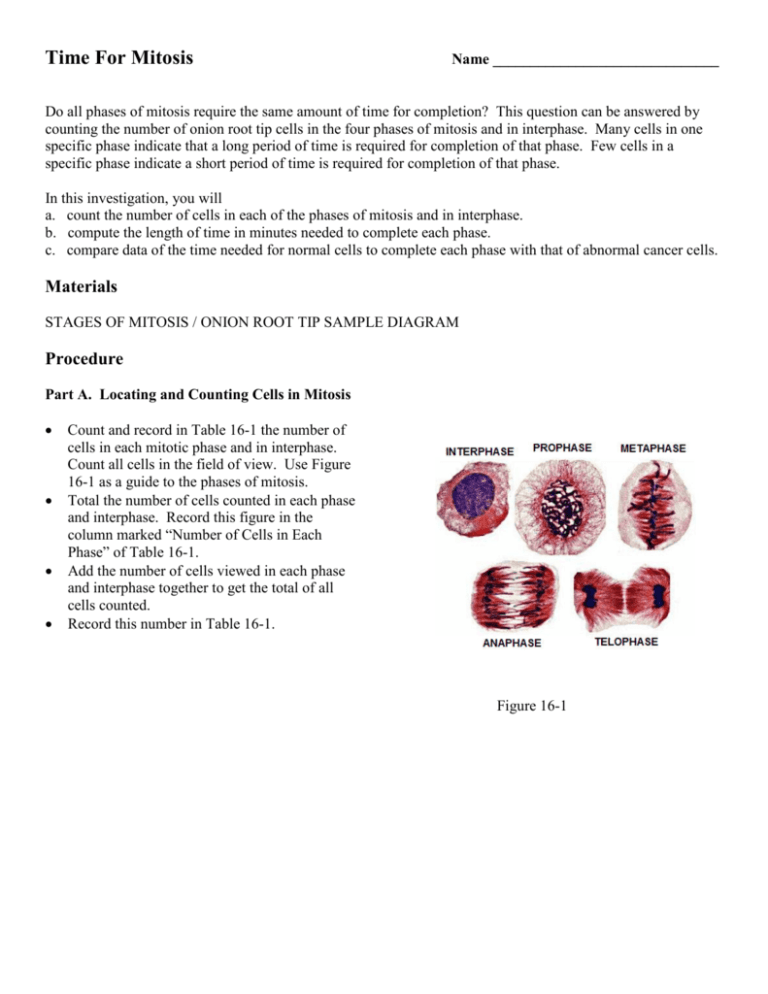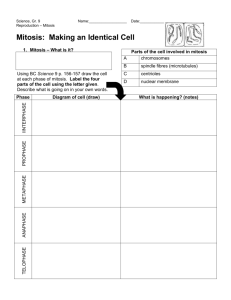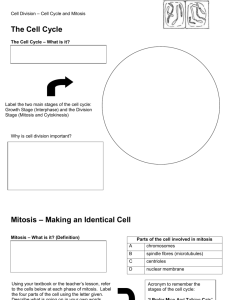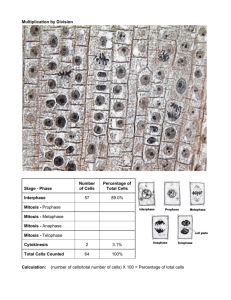Time For Mitosis
advertisement

Time For Mitosis Name ______________________________ Do all phases of mitosis require the same amount of time for completion? This question can be answered by counting the number of onion root tip cells in the four phases of mitosis and in interphase. Many cells in one specific phase indicate that a long period of time is required for completion of that phase. Few cells in a specific phase indicate a short period of time is required for completion of that phase. In this investigation, you will a. count the number of cells in each of the phases of mitosis and in interphase. b. compute the length of time in minutes needed to complete each phase. c. compare data of the time needed for normal cells to complete each phase with that of abnormal cancer cells. Materials STAGES OF MITOSIS / ONION ROOT TIP SAMPLE DIAGRAM Procedure Part A. Locating and Counting Cells in Mitosis • • • • Count and record in Table 16-1 the number of cells in each mitotic phase and in interphase. Count all cells in the field of view. Use Figure 16-1 as a guide to the phases of mitosis. Total the number of cells counted in each phase and interphase. Record this figure in the column marked “Number of Cells in Each Phase” of Table 16-1. Add the number of cells viewed in each phase and interphase together to get the total of all cells counted. Record this number in Table 16-1. Figure 16-1 Part B. Determining the Time Required for Each Phase Assume that the number of cells in a phase is an indication of the time spent in that phase during mitosis. Time spent in a mitotic phase and in interphase can be calculated if the total time for mitosis is known. Onion cells require 12 hours (720 minutes) to complete mitosis (from interphase to interphase). The amount of time needed for a phase can be calculated using the formula: time for a phase = number of cells in a phase total number of cells counted x 720 minutes For example: If 109 cells were counted in metaphase and 980 total cells were counted, then 109 x 720 minutes = 80 minutes 980 • • Calculate the time required for each phase of mitosis using your data. Assume that the total time for mitosis is 720 minutes. Record the times in Table 16-1. Table 16-1 Number of Cells Math to Determine Time In Each Stage Time (In Minutes) In Each Stage Interphase Prophase Metaphase Anaphase Telophase Total Number Counted Analysis 1. Which phase requires the longest time for completion? __________________________________________ 2. Which phase requires the next longest time for completion? ______________________________________ 3. Which phase requires the shortest time for completion? __________________________________________ 4. The following table shows average times required for normal and diseased chicken stomach cells to complete the cell cycle. TABLE 16-2. TIME FOR CELL CYCLE OF NORMAL AND CANCEROUS CHICKEN STOMACH CELLS (IN MINUTES) NORMAL CHICKEN STOMACH CANCEROUS CHICKEN STOMACH CELLS IN MINUTES CELLS IN MINUTES Interphase 540 380 Prophase 60 45 Metaphase 10 10 Anaphase 3 3 Telophase 12 10 2 a. In normal chicken cells, which phase requires the longest time for completion? ____________________ ____________________________________________________________________________________ b. In normal chicken cells, which phase requires the next longest time for completion? ________________ ____________________________________________________________________________________ c. How do your answers to questions 4a and 4b compare with answers to questions 1 and 2? ___________ ____________________________________________________________________________________ 5. a. What is the total time needed for a normal chicken stomach cell to complete mitosis? (Total up the time in minutes for each phase.) ________________________________________________________________ b. What is the total time needed for a cancerous chicken stomach cell to complete mitosis? _______________________________________________________________________________________ 6. How do cancer cells differ from normal cells in total time required for mitosis? _______________________ _______________________________________________________________________________________ 7. How do cancer cells differ from normal cells in time spent for each phase? __________________________ ______________________________________________________________________________________ 8. Table 16-3 shows the length of time (in minutes) needed for mitosis to occur in 2 different normal living organisms. a. Which organism, salamander or pea, shows time needed to complete mitosis most like the data you recorded in Table 16-1? ___________________________________________________________________ b. Why might the time required for these two organisms to complete mitosis be similar? (HINT: Where did the cell material you used in Part A come from?) ____________________________________________ _______________________________________________________________________________________ Salamander kidney cells Pea root cells TABLE 16-3. TIMES NEEDED FOR MITOSIS PROPHASE METAPHASE ANAPHASE TELOPHASE 60 50 6 70 80 40 4 12 TOTAL 186 136 3 Using your data from Table 16-1 and the outline below, prepare a circle graph which shows the number of minutes that onion cells spend in each phase of mitosis. The following suggestions may aid you in preparing your graph. a. Graph your data using the “Time in minutes” column from Table 16-1. b. The circle is divided into 18 minute sections. Each section of the graph equals 18 minutes. If a phase is not exactly 18 minutes long (or some interval close to a multiple of 18 minutes), approximate the position of the line on the graph. c. Shade each phase on your graph with colored pencils or various degrees of pencil shading. d. Identify each phase by shading the key to correspond with the shading on your graph. 4 STAGES OF MITOSIS / ONION ROOT TIP SAMPLE DIAGRAM 5








